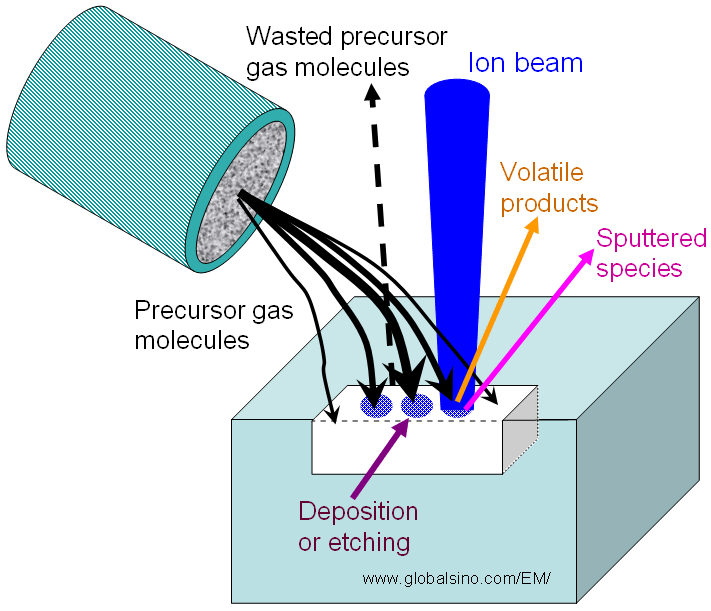=================================================================================
In both electron- and ion-beam deposition methods, the precursor molecules containing target elements are introduced near the surface of a substrate. The molecules are adsorbed on the surface, and then are decomposed by an energetic electron- or ion-beam in a vacuum chamber. The volatile products of the precursor are pumped out while the nonvolatile product containing the target elements remains as a deposit.
In this method, the important deposition characteristics are:
i) Gas delivery systems are used in conjunction with the ion beam to produce deposition.
ii) The gas molecules are adsorbed on the surface in the vicinity of the gas inlet, but decompose only where the ion beam strikes, resulting in site-specific deposition.
In practice, FIB technique is widely used for ion beam assisted chemical vapor deposition (CVD). In the deposition process, a needle is brought to 100 - 200 µm above the target surface. A proper gas (e.g., W(CO)6 for tungsten deposition) is injected from the needle and adsorbs onto the target surface. The Ga+ beam scans over the interesting region of the specimen. The ion beam decomposes the gas, and thus a deposited layer of metal (e.g., W) is left on the surface, while the byproduct (e.g., CO) is removed through the vacuum system. Other deposition materials are conductors such as Pt, Al, Cu, and C, and insulators (e.g., SiO2).
Table 2546. Common materials deposited with FIB technique.
| Deposited material |
Precursor gas |
| W |
Tungsten hexacarbonyl [W(CO)6] |
| Pt |
(methylcyclopentadienyl)trimethyl platinum [C9H17Pt] |
The depositions of metals are often used in silicon semiconductor device modification, and are also used in both SEM and TEM specimen preparation techniques to protect the top surface of interest from sputtering.
The schematic illustration in Figure 2546 presents the locations of the gas source, the focused ion beam, the sample surface, and the volatilized and sputtered species. By selecting the gas source and beam scan conditions, deposition of materials may occur or material removal can be enhanced (see page2473). Therefore, the ion beam assisted CVD process in FIB consists of a fine balance between sputtering and deposition. If the primary ion beam current density is too high on the deposition region, then milling will occur.

Figure 2546. The schematic illustration presenting the locations of the gas source, the focused ion beam, the sample surface, and the volatilized and sputtered species.
|